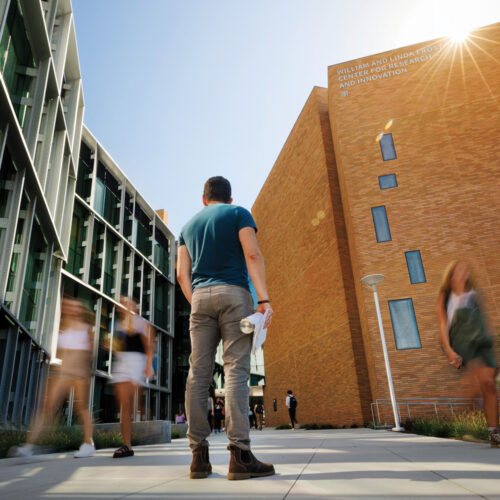Telling the Story of a Building
How do you tell the story of an inanimate object? Editor Larry Peña discusses one of this issue's biggest — and most rewarding — challenges.
 In most of the stories I write, I’m describing a person and sharing what makes them interesting, or recounting a project or event and why it’s important. But a building is a huge, inanimate thing — to get the full picture, you really have to experience it.
In most of the stories I write, I’m describing a person and sharing what makes them interesting, or recounting a project or event and why it’s important. But a building is a huge, inanimate thing — to get the full picture, you really have to experience it.
So how do you tell the story of a building?
That was the challenge for us as we approached this issue and the unveiling of the new William and Linda Frost Center for Research and Innovation.
Late last spring, shortly after major construction finished, the Cal Poly Magazine team got a chance to explore the new building. It was just before the start of summer, and the building was quiet. No classes had yet been scheduled there. A few research groups had begun moving their operations into shiny new labs, but hardly anyone was using the space.
As we walked past the 20-foot-tall “Discere Faciendo” motto (Latin for “Learn by Doing”) outlined in bricks on the outer wall and opened the door to the central atrium, my breath caught in my throat. The space was spectacular: terraces of honey-toned wood and shining glass cast bright, warm light from high above. Open sightlines throughout the building provided easy visual access into every lab, and incredible views of the hills around campus flooded through floor-to-ceiling windows.
It reminded me of a modern luxury hotel — only instead of welcoming you into a decadent vacation experience, it welcomes you into the quest for knowledge.
I can’t replicate that moment for you in these pages — though photographer Joe Johnston’s phenomenal images will give you a great idea of it. But what I can do is tell you about the one thing more important than the building’s highly functional design and stunning aesthetics.
What will make the Frost Center so critical to the future of campus is the impact it will have on people: the faculty who will do fascinating, groundbreaking work there, and the opportunities it will create for students who walk through those doors ready to uncover new knowledge for themselves.
In telling the story of the Frost Center, we focused on the people who will experience Learn by Doing in this beautiful, state-of-the-art new setting. We’ll also introduce you to some of the people who helped make it all possible: the Frosts and other leading donors; alumni who designed and built the facility; and beloved longtime Cal Poly leaders like Phil and Tina Bailey, who revolutionized how science and research are done at Cal Poly.
As one faculty member I spoke to for this story told me, “Tools are important, but they’re just tools — what students really need is the time and space and freedom to experiment.”
That’s the ultimate purpose of the Frost Center, and I hope it’s what you’ll discover in this issue of Cal Poly Magazine.


